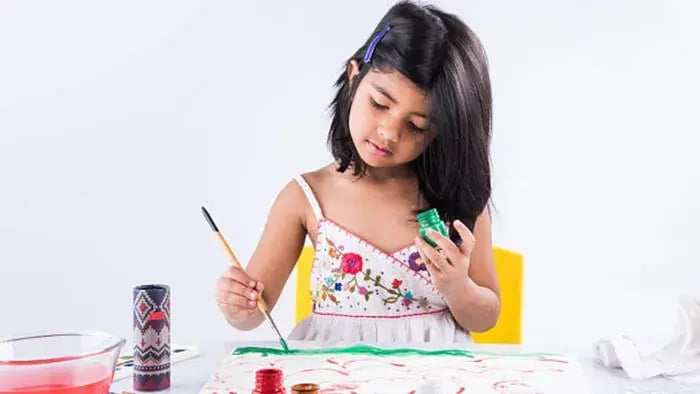Creative Food Drawing Ideas to Teach Kids About Healthy Eating in a Fun Way!
- Improves Memory and Retention
- Encourages Active Learning
- Simplifies Complex Concepts
- Boosts Creativity and Imagination
- Caters to Different Learning Styles
- Develops Communication Skills
- Fruit and Veggie Faces
- Build a Balanced Plate
- Superfood Superheroes
- Healthy vs. Junk Food Sorting
- Rainbow Food Chart
- Design Your Own Smoothie
- Farm to Table
- Healthy Lunchbox Drawing
Introduction
With a dash of creativity and a pinch of health, you can easily teach kids about healthy eating, making it fun and easy. This is one of the best ways to show kids how nutritional food is essential for our bodies. When the colors hit the paper, and they draw fruits and vegetables with other healthy foods they improve their fine motor skills and also develop an interest in healthy eating habits.
This method not only helps kids understand healthy eating but also helps them to recognize different food groups understand the importance of a balanced diet and make healthier choices. This hands-on approach makes learning about food more interactive and fun. Whether it’s drawing a fruit basket, designing a meal plate or creating a food collage these activities promote awareness in a fun way.

Moreover, healthy food drawing helps with motor skills, hand eye coordination and creativity. It also gives parents and teachers an opportunity to talk about the benefits of different foods in a fun way. For example, while coloring an apple you can talk about how apples are high in fiber and vitamins.
This method is especially good for younger kids who may not yet fully understand the concept of nutrition. Through art they can visualize healthy foods in a fun and memorable way.
Reasons Why Visual Learning Is Better For Kids

Improves Memory and Retention
Kids remember visuals better than text because the brain processes images faster. When they see colorful pictures, diagrams or charts the information stays in their memory longer and learning is more effective.
Encourages Active Learning
Visual elements like drawings, videos and interactive charts make learning fun and engaging. Kids are more likely to participate and stay focused when lessons include images rather than just words.
Simplifies Complex Concepts
Some topics like science or math are hard to understand through text alone. Visual aids like diagrams, infographics and animations break down complex ideas into smaller more manageable bits.
Boosts Creativity and Imagination
When kids learn through visuals they start thinking more creatively. Activities like drawing food charts, storytelling with pictures or creating mind maps help kids develop their imagination and problem-solving skills.
Caters to Different Learning Styles
Not all kids learn the same way. Some may struggle with text-heavy lessons but excel when information is presented visually. Using pictures, videos and hands-on activities helps reach all types of learners.
Develops Communication Skills
Visual learning helps kids express themselves better. Whether they draw, use flashcards or watch educational videos, these tools help them understand and communicate ideas more clearly.
8 Healthy Food Drawing Ideas for Kids: Fun Ways to Learn Nutrition Through Art

Fruit and Veggie Faces
Have your child draw fun faces using different fruits and veggies. A banana can be a smile, grapes can be eyes, and a carrot can be a nose. This helps kids recognize different food items and get more excited about eating healthy.
Build a Balanced Plate
Have your child draw a plate with different food groups fruits, veggies, proteins, dairy, grains. You can talk about why each group is important while they color. This helps kids understand portion sizes and why a balanced diet is super important.
Superfood Superheroes
Have your child design superheroes inspired by healthy foods like “Mighty Mango” or “Captain Carrot.” This is a fun way to learn about the benefits of different foods and makes eating healthy seem powerful.
Healthy vs. Junk Food Sorting
Give your child a mix of food images or words and have them draw two baskets one for healthy foods and one for junk foods. This helps them learn to distinguish between nutritious and not so nutritious options in a fun way.
Rainbow Food Chart
Get your child to draw and color foods from every color of the rainbow. Red apples, orange carrots, yellow bananas and green spinach help kids learn that different colors mean different nutrients, so mealtimes are more fun.
Design Your Own Smoothie
Let kids design and color their own healthy smoothie, choosing ingredients like berries, yogurt, nuts and seeds. This gets them to try different nutritious options and feel part of the healthy eating choices.
Farm to Table
Get your child to draw the journey of a fruit or vegetable – from the farm to the kitchen. This helps them understand where their food comes from and appreciate fresh, natural ingredients over processed ones.
Healthy Lunchbox Drawing
Challenge kids to design a healthy lunchbox with their favorite nutritious foods. This helps them make better choices when packing their lunch and get excited about eating well at school.
Tarishi Shrivastava is a young writer who has covered a range of topics on children's health, including nutrition, fitness, sleep, and parent-child bonding. With a keen interest in simplifying wellness for parents, she brings a practical and engaging approach to her writing. Beyond work, she enjoys exploring new ideas, staying curious, and creating meaningful content.
The views expressed are that of the expert alone.
The information provided in this content is for informational purposes only and should not be considered a substitute for professional medical advice, diagnosis, or treatment. Always seek the advice of your physician or another qualified healthcare provider before making any significant changes to your diet, exercise, or medication routines.










